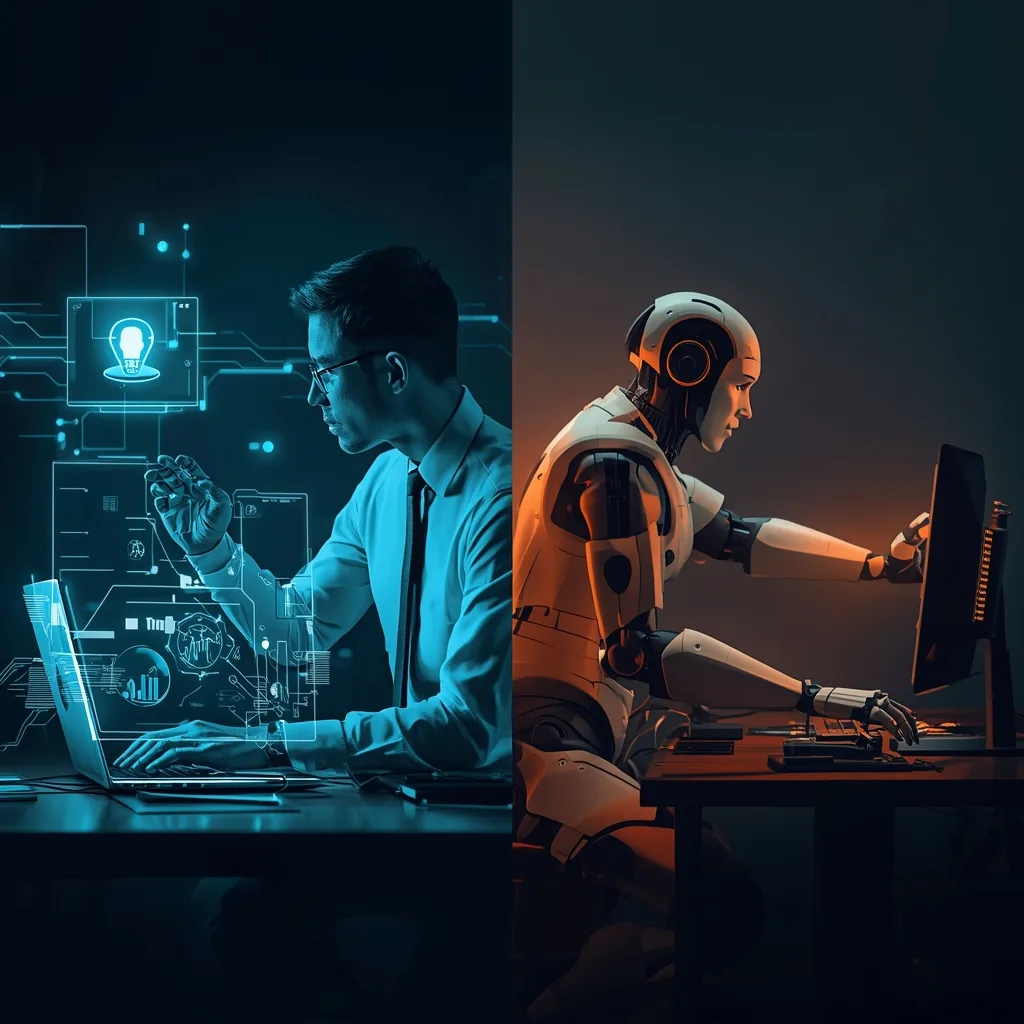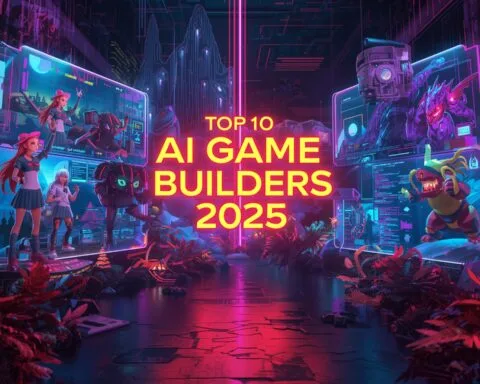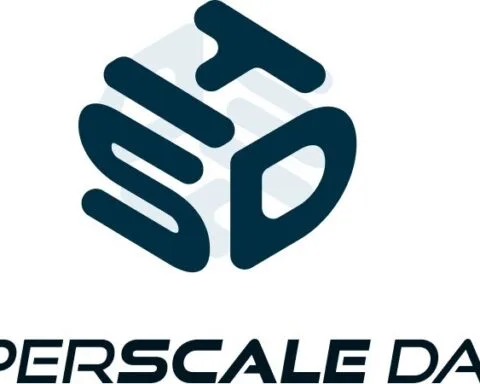Last Updated on September 9, 2025 11:55 am by Laszlo Szabo / NowadAIs | Published on September 9, 2025 by Laszlo Szabo / NowadAIs
AI as Augmentation vs. Replacement: The Real Battle for the Future of Work – Key Notes Section
AI augmentation supports and amplifies human roles instead of eliminating them, promoting collaboration and new opportunities.
Replacement occurs where tasks are repetitive and rule-based, boosting efficiency but risking job displacement, especially for entry-level roles.
The most successful workplaces blend AI augmentation and replacement, combining machine speed with human judgment for optimal results.
The Meaning Behind the Debate
One of the hottest topics in tech circles today is “AI as Augmentation vs. Replacement.” The debate addresses whether artificial intelligence should serve as an assistant to humans—amplifying our abilities—or whether it should take over entire tasks, possibly sidelining people in the process. It’s not a dry theory: this is about the future of how we work, learn, create, and make decisions. The stakes are high, with everything from productivity to job satisfaction on the line. Instead of only automating routine tasks, AI can become a partner that helps us think deeper, spot patterns faster, and focus on higher-level problem solving.
The Nuts and Bolts: Defining Augmentation and Replacement
When discussing AI as Augmentation vs. Replacement, it’s important to clarify terms. “Replacement” refers to situations where AI completely takes over a task or job. Think classic examples: a robotic arm running an assembly line, or chatbots handling support tickets from start to finish. By contrast, “augmentation” means artificial intelligence works alongside humans, expanding capabilities instead of kicking people out of the loop. For instance, an AI might highlight suspicious transactions for a bank employee to review, or help a doctor spot subtle details in X-rays while leaving the final decision to the expert.
Early AI: The Age of Automation
Initially, much of AI’s energy focused on automation—substituting repetitive work with efficient algorithms. Robotic Process Automation (RPA) swept through finance, admin, and retail, making invoice reconciliation and data sorting faster and nearly error-free(Source). Yet, there is a limit to what pure automation can achieve. Tasks that need judgment, adaptation, or empathy are tough nuts for machines to crack.
Augmentation: AI’s Collaborative Superpower
AI as Augmentation vs. Replacement highlights how augmentation empowers people instead of leaving them behind. Imagine a consultant who summarizes thousands of reports with GPT-4, or a radiologist who reviews AI-flagged anomalies before making her diagnosis. The professional isn’t replaced—they’re backed up by an ever-watchful, data-driven partner. Augmented intelligence can also support creative tasks—from music composition to architectural design—by suggesting novel combinations that might never be found by human intuition alone.
Industry Impact: Who Benefits—and Who Should Worry
AI as Augmentation vs. Replacement matters most in industries where routine, rule-based work is common. Data entry clerks, bank tellers, and retail cashiers are at growing risk of total replacement, as software can process documents, handle transactions, and manage inventory with greater speed and lower error rates. On the flip side, jobs that blend technical know-how with interpersonal skills—like teachers, nurses, and consultants—are less likely to be replaced. These roles stand to benefit from AI augmentation, using technology to handle administrative burdens so they can devote more energy to human-centric work.
Human-AI Collaboration Models
There isn’t a one-size-fits-all approach to AI as Augmentation vs. Replacement. Some companies prefer an equal division of labor, such as HR teams leveraging AI for screening but still conducting interviews themselves. Others use human-in-the-loop systems, where AI handles most tasks, but humans step in for edge cases and high-stakes decisions. At the fringes, some operations opt for minimal collaboration, where humans set parameters and check results while AI runs the show autonomously.
Real-World Examples: Augmentation in Action
Consider healthcare, where AI “reads” medical scans and flags possible issues, alerting the doctor, who makes the final call. In engineering, computer-aided design tools propose alterations to blueprints, but the architect decides which ideas to pursue (Source). Legal researchers use AI-driven platforms to sift through huge troves of documents, surfacing relevant cases so lawyers can focus on strategy.
Replacement: Efficiency at a Cost
For AI as Augmentation vs. Replacement, automation promises unparalleled efficiency for certain industries. Manufacturing plants hum with robotic arms, sorting thousands of widgets per hour. Warehouses optimize routes for their picking robots. Even newsroom headlines are increasingly penned by algorithmic writers when quick summaries are needed. It’s hard to argue with the raw outcome: fewer errors, lower costs, more standardized results. Yet, this comes with the price of reducing opportunities for entry-level positions or roles that previously depended on repetition.
Augmentation Beyond Business: Everyday Advantages
AI as Augmentation vs. Replacement isn’t just for business titans. Augmentation finds its way into everyday help—from virtual assistants who organize calendars and grocery lists, to translation tools that help bridge language gaps for travelers. Smart home systems suggest optimal energy use, while fitness apps analyze your workout data for personalized recommendations. Here, AI doesn’t replace the person—it amplifies what they can accomplish on their own.
Societal Perspectives: Augmentation vs. Replacement in Public Opinion
According to academic research, “replacement” AI often sparks anxiety, with fears of job loss and depersonalized service. By contrast, tools designed for augmentation—those that keep humans in the center of the action—generate more positive attitudes. People feel more comfortable when AI is a co-pilot rather than a driverless machine.
Hybrid Futures: The Reality of Mixed Workflows

In truth, “AI as Augmentation vs. Replacement” is rarely an all-or-nothing choice. Most jobs today blend elements of both. For example, an airline pilot uses automated flight control systems but still initiates takeoff and landing. A marketing manager relies on AI data analytics but crafts the creative pitch herself. Hybrid workflows allow companies to maximize the strengths of both people and machines, mixing speed and accuracy with empathy and context.
The Economic Ripple Effect
When examining “AI as Augmentation vs. Replacement,” the broader economic effects are impossible to ignore. While some jobs may vanish, new ones are born. AI specialists, trainers, and ethicists are on the rise, and even existing jobs may evolve, requiring upskilling so people can work alongside their digital teammates (Source). Businesses investing in augmentation frequently see improved innovation, better outcomes, and greater worker retention, leveraging human strengths with the speed of AI.
Challenges and Concerns
Adopting AI augmentation comes with its own set of hurdles. For instance, staff may need new training to work effectively with AI tools, and organizations must establish clear standards about when machines make decisions vs. when humans have the final say. In terms of replacement, it raises questions of fairness and economic security. Governments and institutions need policies ensuring displaced workers have access to retraining and support (Source)
The Road Ahead: Choosing Collaboration over Competition
The ongoing debate around “AI as Augmentation vs. Replacement” centers not just on technology, but on values and priorities. Whether in business, medicine, education, or daily life, most experts recognize that machines perform best when they support and extend human skill. It takes thoughtful planning to blend teamwork and trust—letting AI handle drudgery, while people take the lead for judgment and creativity (Source).
Final Thoughts: What Should We Aim For?
Given the evidence, AI as Augmentation vs. Replacement is a spectrum, not a binary. While routine jobs fade or reshape under AI’s gaze, enhanced partnerships blossom where people and artificial intelligence combine forces. Ultimately, the most powerful outcomes come not from machines taking over, but from humans and AI building smarter, faster, and kinder workplaces together.
Definitions Section
AI Augmentation: Using artificial intelligence to help humans make better decisions, perform tasks more efficiently, and boost creativity.
Automation: The process by which machines or programs carry out tasks with minimal human intervention, usually for repetitive activities.
Human-in-the-Loop: A system where AI performs tasks but requires human oversight or involvement for key decisions.
Robotic Process Automation (RPA): Software robots that complete repetitive digital tasks without needing human supervision.
Hybrid Workflow: Combining both AI-driven automation and augmentation so humans and machines share responsibilities.
Frequently Asked Questions (FAQ)
Q: What does “AI as Augmentation vs. Replacement” really mean?
A: The concept of AI as Augmentation vs. Replacement addresses whether artificial intelligence should act as a supportive tool for humans or completely take over certain tasks. Augmentation means AI works alongside people, enhancing their abilities, while replacement describes a scenario where AI systems do the full job independently. This distinction matters because augmentation generally fosters greater creativity, innovation, and job satisfaction, while replacement is typically favored for tasks that are repetitive and easily standardized. Understanding this difference helps organizations deploy AI solutions that best fit their goals and values.
Q: Why is AI augmentation preferable in many industries?
A: AI as Augmentation vs. Replacement is often more desirable in sectors that require nuanced thinking, creativity, and human interaction. Augmentation allows employees to focus on complex challenges while delegating routine or data-heavy tasks to AI. The approach results in more fulfilling work and typically leads to better business outcomes. Augmentation also decreases errors by combining human judgment with AI’s analytical power, serving as an ally rather than an adversary in fields like healthcare, education, and law.
Q: Are any job roles entirely safe from AI replacement?
A: While AI as Augmentation vs. Replacement will continuously evolve, most jobs that rely heavily on empathy, interpersonal relationships, or complex judgment are less susceptible to being completely replaced. Roles such as teachers, mental health professionals, and creative artists thrive especially under an augmentation model, as AI can support but not substitute the uniquely human elements required. Still, no role is completely immune, so continuous learning and adaptation are important as AI continues to develop.
Q: What steps should businesses take to harness AI augmentation successfully?
A: Businesses aiming to capitalize on AI as Augmentation vs. Replacement should focus on upskilling employees, designing work processes that bring out the best of both humans and machines, and developing clear guidelines about when AI should assist or act autonomously. Organizations should also monitor the impact on job satisfaction and make adjustments to ensure technology acts as a support mechanism rather than reducing human value. Thoughtful integration leads to sustainable growth and happier, more productive teams.
Q: How can individuals prepare for the future impact of AI as Augmentation vs. Replacement?
A: Individuals should stay informed about emerging AI technologies and prioritize developing skills that AI cannot easily duplicate, such as creative, social, and strategic thinking. Embracing AI augmentation by learning to use relevant tools makes workers more valuable, while understanding the risks of replacement helps in advocating for fair workplace practices. Continual learning and openness to collaboration with AI are key strategies for thriving in an increasingly digital world.







